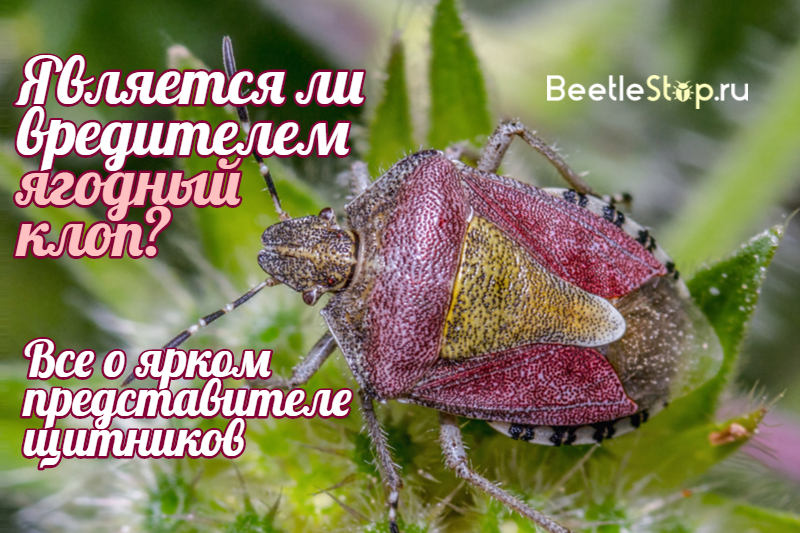Berry bug
Berry bug belongs to the family of real shield bugs. Like all representatives of this family, it has a characteristic triangular body shape and an unpleasant odor emitted by an insect in case of danger. A photo of a berry bug is little able to convey all the charm of this little squire, however, it will still allow him to be recognized at a meeting.

What does a berry bug look like?
Scutellaria berry is a relatively small representative of its family. The length of his body is only 10-12 mm. An adult insect is able to change its color, adapting to the color of the surrounding foliage. So, for example, in the summer you can meet a bug with a bright burgundy color, and in the autumn the same insect will wear brownish-brown clothes.
The sides and antennae of the buttock look very impressive in a black and yellow transverse strip. According to this characteristic pattern, it can easily be distinguished from other shield insects.
The larva looks very similar to an adult insect, but has a gray masking color without a bright rim on its sides and is covered with bright fluffy hairs.
Over time, she will lose her infant fluff and put on a bright adult outfit. However, this will happen no earlier than one and a half months.
For all the time of growing up, a small bug bug will drop its skin 5 times before it reaches the adult stage.
Females lay their eggs on the leaves of plants and on the surface of berries in May - June. Within a week, small bugs emerge from them, which for the first time are kept in a heap, and then spread throughout the plant.
Contrary to its name, the berry bug does not at all eat only the fruits of gardening. You can meet him on different plants, including weeds. He loves colza and other herbs with juicy tender leaves.
Eating, the insect punctures its leaves with its proboscis and sucks the juices out of them. Subsequently, the damaged area turns pale and dries. If there are many pests, then the plant may soon die.
Advice! In order to protect the garden from raids of berry bugs, it is necessary to timely clean last year's foliage and carry out planned treatment of the site from pests.
Bed bugs - who are they?
Shield guards are a rather large family. In the world there are more than 4000 species. Among them there are not only herbivores, but also predators. For example, a tree shield attacks caterpillars and small insects, sucking out vital juices from them. You can distinguish a predator by a thick proboscis, specially adapted for piercing the covers of its victims.
By the way, outwardly, the woody shield is quite similar to its herbivorous relative, however, if you look closely, the berry bug looks somewhat different. Even in the fall, when its color turns pale, the characteristic stripes on the sides of the body will not make a mistake.
A characteristic feature of all shieldworms is a sharp, unpleasant odor released by insects from holes in the abdomen. It is to this aroma that the shield insects owe their second name - stink bugs. It is quite difficult to get rid of the unpleasant odor, so insectivorous predators, and the rest of the animals, try to bypass the shield.
Interesting fact! The odorous discharge of insect bugs is nothing more than cimicinic acid.For insects, it is a contact poison and in large quantities it can cause paralysis and death of a daredevil who dares to attack a stink of a predator.
Berry bug - a pest?
Despite the fact that the berry bug harms plants by drinking their juices, it does not cause much damage to gardens. The small number and omnivorous nature of this insect does not pose a particular threat to the crop, so it can be called a pest with a big stretch.
Berry shields do not like to flaunt themselves and prefer to sit peacefully somewhere on a bush, drinking a sweet vegetable juice. They got their name, most likely, precisely because of their inconspicuousness, because, having only inadvertently clutched at a berry, chosen by the bug, and smelling it, we notice it and call it a stink in our hearts.
You can find out how the representatives of the family of shieldworms look in nature by watching the video:


 (votes: 3, average rating: 4,33 out of 5)
(votes: 3, average rating: 4,33 out of 5)